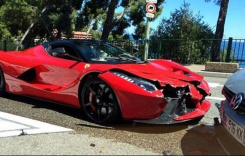Indian Motorcycle hit the jackpot when it resurrected the storied Scout model. Messing with a historic model is always a gamble, especially one with such a fabled history as the Scout, and expectations placed on the next-gen Scout were high. When Indian launched the new Scout with a cast aluminum frame, bolted the shocks directly to the rear casting, and squeezed its 60 degree V-Twin with machined cases tightly into that package, it was a drastic deviation from the brand’s norm. Which wasn’t a bad thing, because as soon as riders hitched a leg over the new Scout, they were quickly sold on the merits of its performance.

The 2015 Scout was a Sportster slayer, quicker off the line, quicker in the turns, higher revving with more horsepower. We know, because we pitted the two against one another (2015 Harley Sportster vs Indian Scout). The Scout has been a huge commercial success, so hearing news that Indian was launching the 2016 Scout Sixty at EICMA came as a bit of a surprise. Even more so when we learned that besides dropping a few cc’s of displacement and a gear from the transmission this new Scout was, to borrow a line from the Talking Heads, “the same as it ever was.”
Indian’s strategy with the Scout Sixty makes more sense, however, once compared to its American rival, as Harley-Davidson produces both a 1200 and 883 version of its popular Sportster. Dropping the Scout’s price point a couple grand will get more people in its saddle. Toning down the power delivery just a tad on a motorcycle that’s already easy to handle and has a super-low seat height edges it closer to entry-level motorcycle territory. Up to this juncture, Indian still lacked a feeder bike since its reemergence in the market – and every manufacturer understands the importance of getting consumers to swill the brand elixir early, hoping to hook them for life.

We couldn’t wait to hitch a leg over the 2016 Indian Scout Sixty as we tore out of Las Vegas on a 115-mile journey through the Nevada desert to Lake Mead. The adventure mixed highway miles with the splendid twists and turns surrounding Lake Mead, the route’s long straights allowing us to push the 999cc engine to its limits combined with fast sweepers to sample its handling.
Crack the throttle on the Indian Scout Sixty and it rings with familiarity. The engine retains the same linear, revvy nature that endeared us so much with the 1133cc version. Granted, there’s not quite the same explosion of low-end torque, but there’s still no shortage of power on tap. First gear will propel you up to 55 mph until it bangs off the rev limiter at around 8250 rpm. Second gear has the same rpm ceiling but by then you’re into the mid-80s, just shy of what second gear on the standard Scout will get you. In fifth gear it settles in nicely around the 4000 rpm range at highway speeds, and though the Sixty is a little down on roll-on power compared to its larger-displacement counterpart, it never left us wanting for another gear. While the engine continues to churn at the same 2.89-inch stroke, it does so in a slightly smaller cylinder, the Scout Sixty’s bore trimmed down to 3.66-inches from the 1133cc Scout’s 3.89-inch dimensions.
The smooth-shifting gearbox continues to impress with the same predictability that sold us on the initial Scout. Action is light, engagement precise, and finding neutral is fuss-free. In its conversion to a five-speed transmission, Indian states fifth gear was removed from the gear cluster of the standard Scout’s six-speed gearbox. This explains why the fifth gear ratio on the Scout Sixty dropped from 4.380:1 to 4.034:1 compared to the six-speeder, as it is the same ratio as sixth gear on the 1133cc model. Rifling through said gears, bang it down one and the revised transmission exhibits a generous amount of engine braking.
Hustling through the broad sweeping turns around Lake Mead, handling on the Indian Scout Sixty is atypical for a cruiser. Steering is light and a low center of gravity makes for smooth, quick transitions. The meaty, muscly front tire provides a generous contact patch and lends to the front end’s stability when on its edges. Even though the motorcycle is slung low, the forward-mounted pegs are high enough to allow for healthy amounts of lean. Suspension on the rear is a bit stiff and travel is short, so it can be harsh on big hits. The rear continues to utilize adjustable dual shocks, the only difference being a new top-out spring on the Scout Sixty.

The return of the Scout has equated to big sales for Indian. The company hopes the smaller displacement Scout Sixty continues that trend by broadening the models range.
The braking package is unchanged, as 298mm rotors anchor both the front and back, with twin-pot calipers fore and a single aft. Tested solely at freeway speeds, the front brake isn’t overpowering. Pressure is moderate but even and didn’t fade as we continued to squeeze. The back brake is a little grabby and will lock the back wheel with a good stab. The foot lever for the rear brake is on the small side as I could only get a precarious corner of my foot flush on the lever.
Despite having an ultra-low 25.3-inch laden seat height, the riding position still allows me to stretch out at six-feet-tall thanks to its forward-mounted controls and bar placement. The saddle is comfortable and well designed, so pressure points are few. Granted, our continuous stints in the seat never stretched more than an hour at a time, but the spells we were straddled aboard the Scout Sixty were spent pleasantly. After riding the junior Scout, we find it hard to believe the Sixty’s claimed 542-pound dry weight is actually four pounds heavier than the 1133cc version. Maybe it’s the slightly softer power delivery or easy-going nature of its handling, because it sure feels lighter that the standard version.

The same weekend we sampled the Scout Sixty for ourselves we also witnessed the potential of the Scout Sixty both as a custom bike and flat tracker thanks to RSD. The crew over at Roland Sands Design got their hands on five pre-production units and put the flat-track spin on them, bumping the stock 16-inch wheels up to 19s, redoing the tail section, upgrading suspension and swapping out pipes. Roland and four of his buddies then proceeded to thrash the hell out of them at the SuperHooligan races held at the inaugural Superprestigio races, where they were bangin’ bars and kickin’ up roost on the short dirt track set up inside Orleans Arena. Afterward Roland, wide grin on his face, compared the experience to riding a 450. Indian reiterated its history of flat track racing several times during the course of the evening, providing potential clues to reasons behind the Scout Sixty’s development.
While we were concerned the Scout 2.0 might come across as a neutered version of the original, that is not the case. It’s still got power, is quick off the line, precise in the turns and a blast to ride. The Scout line continues to be a breath of freshness in the cruiser realm, a bike with familiar creature cruiser comforts combined with a performance bend that the niche commonly lacks. At a couple grand less, the Scout Sixty should be just the tonic to get more riders into Indian’s seats.









